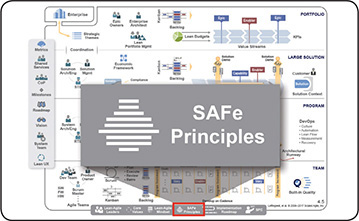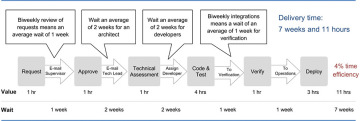- Principle #1: Take an economic view
- Principle #2: Apply systems thinking
- Principle #3: Assume variability; preserve options
- Principle #4: Build incrementally with fast, integrated learning cycles
- Principle #5: Base milestones on objective evaluation of working systems
- Principle #6: Visualize and limit WIP, reduce batch sizes, and manage queue lengths
- Principle #7: Apply cadence, synchronize with cross-domain planning
- Principle #8: Unlock the intrinsic motivation of knowledge workers
- Principle #9: Decentralize decision-making
Principle #2: Apply systems thinking

A system must be managed. It will not manage itself. Left to themselves, components become selfish, competitive, independent profit centers, and thus destroy the system. The secret is cooperation between components toward the aim of the organization.
—W. Edwards Deming
The three foundational bodies of knowledge that inform SAFe are systems thinking, Agile development, and Lean product development. Systems thinking takes a holistic approach to solution development, incorporating all aspects of a system and its environment into the design, development, deployment, and maintenance of the system itself.
Figure 1 illustrates the three primary aspects of systems thinking.

Figure 1. Three aspects of systems thinking
Understanding these concepts helps leaders and teams navigate the complexity of solution development, the organization, and the larger picture of total time-to-market. Each is described in the following sections.
The Solution Is a System

SAFe guides the development and deployment of complex software and cyber-physical systems. They are represented by the SAFe Solution object, the tangible object that delivers the end user’s value and is the subject of each Value Stream—the application, satellite, medical device, or website. When it comes to such tangible systems, Deming’s comment that “a system must be managed” leads to some critical insights:
Team members must understand clearly where the boundaries of the system are, what the system is, and how it interacts with the environment and systems around it.
Optimizing a component does not optimize the system. Components can become selfish and hog the resources—computing power, memory, electrical power, whatever—that other elements need.
For the system to behave well as a system, intended behavior and some higher-level understanding of its architecture (how the components work together to accomplish the aim of the system) must be understood. Intentional design is fundamental to systems thinking.
The value of a system passes through its interconnections. Those interfaces—and the dependencies they create—are critical to providing ultimate value. Continuous attention to those interfaces and interactions is vital.
A system can evolve no faster than its slowest integration point. The faster the full system can be integrated and evaluated, the faster the system knowledge grows.
The Enterprise Building the System Is a System, Too

There’s a second aspect to systems thinking: The people, management, and processes of the organization that builds the system are also a system. The understanding that systems must be managed applies here as well. Otherwise, the components of the organization building the system will optimize locally and become selfish, limiting the speed and quality of value delivery. This leads to another set of systems thinking insights:
Building complex systems is a social endeavor. Therefore, leaders must cultivate an environment where people can collaborate on the best way to build better systems.
Suppliers and customers are integral to the value stream. They must be treated as partners, based on a long-term foundation of trust.
Optimizing a component does not optimize the system in this case, either. Likewise, optimizing local teams or functional departments does not necessarily enhance the flow of value through the enterprise.
Value crosses organizational boundaries. Accelerating its delivery requires eliminating silos or creating cross-functional organizations, such as Agile Release Trains (ARTs).
Understand and Optimize the Full Value Stream

Value streams are fundamental to SAFe. A SAFe portfolio is essentially a collection of value streams, each of which delivers one or more solutions to the market. As illustrated in Figure 2, each value stream consists of the steps necessary to integrate and deploy a new concept through a new or existing system.

Figure 2. The solution development value stream
Understanding and optimizing the full value stream—the third aspect of systems thinking—is the only way to reduce the total time it takes to go from concept to cash [2]. Systems thinking mandates that leaders and practitioners grasp and continuously optimize the full value stream, especially as it crosses technical and organizational boundaries.
One essential process is value stream mapping, a systematic way to view all the steps required to produce value. Value stream mapping allows leaders to quickly recognize that the actual value-added processing steps—creating code and components, deployment, validation, and so forth—consume only a small portion of the total time-to-market. This recognition drives leaders to constantly focus on the delays between steps. An example of a value stream map is provided in Figure 3. Note that almost all the time between feature request and deployment in this figure is wait time, resulting in a highly inefficient process.

Figure 3. Value stream mapping example: most of the time is wait time
Only Management Can Change the System
Everyone is already doing their best; the problems are with the system … only management can change the system.
—W. Edwards Deming
This Deming quote prepares us for a final set of insights. Systems thinking requires a new approach to management—that is, a perspective in which managers are problem solvers, take the long view, proactively eliminate impediments, and lead the changes necessary to improve systems and performance. These Lean-Agile Leaders:
Exhibit and teach systems thinking and Lean-Agile values, principles, and practices
Engage in solving problems and eliminating roadblocks and ineffective internal systems
Apply and teach root cause analysis and corrective action techniques
Collaborate with the teams to reflect at key Milestones and identify and address shortcomings
Take a long-term view, investing in enabling capabilities such as infrastructure, practices, and tools and training that lead to faster value delivery and higher quality and productivity
Summary
Understanding the elements of systems thinking helps leaders and teams recognize the ‘why’ and the ‘what’ of their actions, as well as the impact on those around them. This leads to a leaner, smarter enterprise that can better navigate organization and solution development complexities, which in turn results in better business outcomes.

